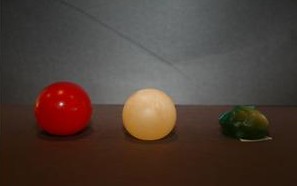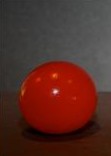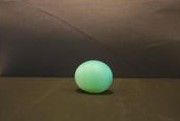Eggs are good to eat. But eggs can also teach us science. Here are two experiments that you can do with eggs. Remember—even though eggs are food, you should not eat the eggs that you use for these experiments! Eggshells are made of a chemical—calcium carbonate. You can perform a chemical reaction and make the calcium carbonate dissolve. This may sound messy, but eggs actually have a membrane between the shell and the white/yolk that will remain after the shell dissolves. (You can see this membrane when you peel a hard boiled egg.)
The membrane surrounding the egg has a special property. It will allow small molecules (like water) to pass through it, but it keeps large molecules like proteins and fats (the white and the yolk) inside. This process is called osmosis. You can observe this process using the shell-less eggs, water and corn syrup.
Disappearing Egg Shells
• Eggs
• Container large enough to hold eggs
• Vinegar
1) Put some eggs in the jar/container. Add enough to completely cover the eggs. What do you see? Bubbles will start to form on the eggs. Cover the container and place it in the refrigerator.
2) Check your eggs after 12-24 hours. What has happened? Carefully remove the eggs from the container and gently rinse them under running water. If some eggshell still remains, put the eggs back into the container and add fresh vinegar. Check the eggs again after another 12-24 hours.
3) When the shell is all gone, make some observations. Carefully hold the egg and notice how it feels. Hold it up to a light—what do you see? With an adult helper, working over the sink, see what happens if you gently squeeze the egg.

Disappearing Egg Shells, Part Two
• Shell-less eggs (3 or more)
• 3 containers
• Water
• Corn syrupFood coloring (optional)
1) Label the containers ‘water’, ‘corn syrup’ and ‘control’. Place an egg in each container.
2) Cover the egg labeled ‘water’ with water. Add food coloring, if you’d like. Cover the egg labeled ‘corn syrup’ with corn syrup. If you want use food coloring, add it to the corn syrup before you pour the corn syrup over the egg. Leave the egg in the control container alone.
3) Put the eggs in the refrigerator for at least 6 hours.
4) Carefully remove the eggs from their containers and observe them. What has happened to each egg? Use the uncovered egg (the control) to remind you what each egg looked like before you put it in water or corn syrup. Try putting the egg from the corn syrup into water for a few hours. What happens?
Why does this work?
Eggshells are made of a chemical called calcium carbonate. Calcium carbonate is a base. Vinegar is another name for a chemical called acetic acid which is (of course!) an acid. Acids and bases react with each other. In this case, the reaction makes new chemicals that are soluble in water so the eggshell dissolves. The reaction also creates carbon dioxide gas. If you looked carefully when you put the eggs into the vinegar you probably noticed small bubbles forming. These are carbon dioxide bubbles.

Once the eggshell dissolves, the white and yolk are held in a membrane. Scientists call this membrane semi-permeable because only some things can pass through it. It will allow small molecules (like water) to pass through it, but it keeps large molecules like proteins and fats (the white and the yolk) inside. This process is called osmosis.
In osmosis, the water molecules move from the area with more water molecules to the area with fewer water molecules. The inside of the egg is mostly, but not all water (about 90% water). When you put the egg into pure water, some of the water molecules from the solution move into the egg and the egg swells up. You can tell this happens easily if you use food coloring because the egg will change color. You can also observe that the egg is slightly bigger than the untreated egg.
Corn syrup is only about 25% water. When you put an egg in corn syrup, water will move out of the egg and it will appear shriveled. If you use food coloring in the corn syrup, you may wonder why the egg turns color, if the water is flowing out of the egg. This happens because, while most of the water molecules flow out of the egg, after some time passes, water molecules pass into the egg at the same rate as they are flowing out. This is called a dynamic equilbrium.

If you want to try something else, take the egg that was in the corn syrup and put it into water. What do you think will happen? This picture may give you a clue!







